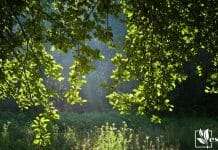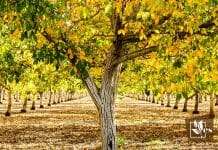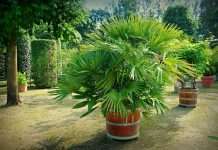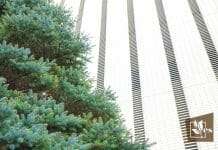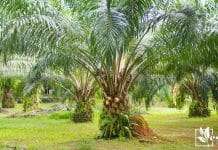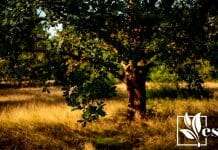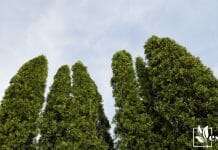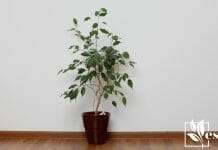- 6 Cactus Plants With Pink Flowers: Stunning & Little Effort - March 28, 2024
- 6 Alternative To String Trimmer: Useful Common Options - March 28, 2024
- Oil Coming Out of Lawn Mower Exhaust? Reasons and Fixes - March 28, 2024
Which one comes out on top in a juniper vs cypress showdown? Both come in a variety of shapes and sizes, from dwarf to giant. How much does their size even matter?
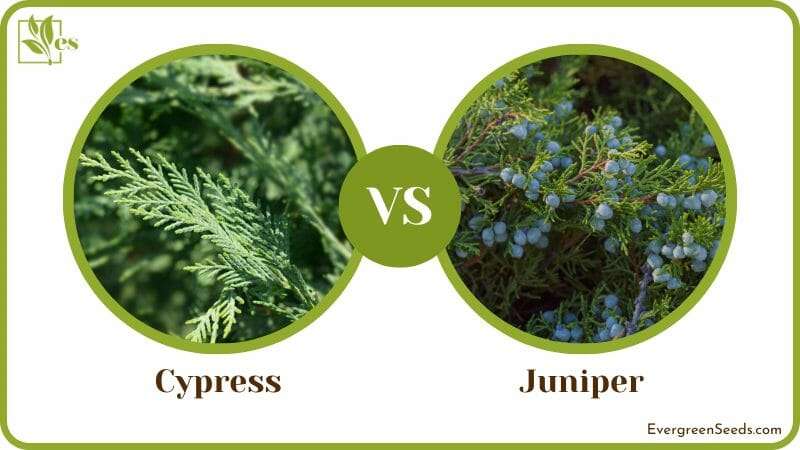
Read on and find out the answer in our juniper vs cypress showdown.
JUMP TO TOPIC
Cypress vs Juniper
Cypress (Cupressus) is a tree family split into 130 species living all over the globe. They are all coniferous and include what’s known as “true cypress” but also a “false cypress.” Some cypress species are native to North and others to South America.
Juniper (Juniperus) is also a coniferous tree family split into 60 species. Like cypress, juniper species grow all across the world, with plenty of native species. Junipers can be shrubs, trees, and evergreen groundcovers. They can be a good cypress alternative.
Both cypress and juniper belong to the same family, Cupressaceae.
Both Have the Same Traits, Such As:
- evergreen trees
- landscape plant appeal
- yellow to green and gray foliage
- needle-like leaves
- cones
What Is the Size and Shape of Juniper and Cypress?
Both juniper and cypress can grow up to 130 feet high and up to 50 feet wide, depending on the species. Both can be anything from a tiny shrub to a massive, tall tree shaped like a column or pyramid.
Leyland cypress is a pyramidal tree that reaches up to 50 feet. It takes about 15 years for the tree to reach that height. Bald cypress can be 70 feet high and 30 feet wide, taking about the same time to grow that big. Cypresses most often flatten and spread out as they age.
California juniper can grow 45 feet tall and spread 50 feet wide. Common juniper is either a medium shrub 5–10 feet high or a small tree up to 25 feet high. You might need to tie smaller trees to a stake to keep them upright.
How Much Sun Do Juniper and Cypress Need?
Junipers prefer full sun but can also handle partial shade. It needs at least 6 hours of sun each day.
Cypress needs a lot of sun to grow. If you’re caring for a cypress seedling, remove all nearby items to boost sunlight exposure. Cypress grows in USDA zones 6–10 but can be finicky if there’s too little or too much water.
Water Requirements
Junipers need little water when planted on the coast, but inland junipers need some water in the summer. You shouldn’t plant a juniper beside a lawn sprinkler. Don’t water junipers except in severe droughts; overwatering can kill them. Even in a drought, just give them enough water to moisten the soil.
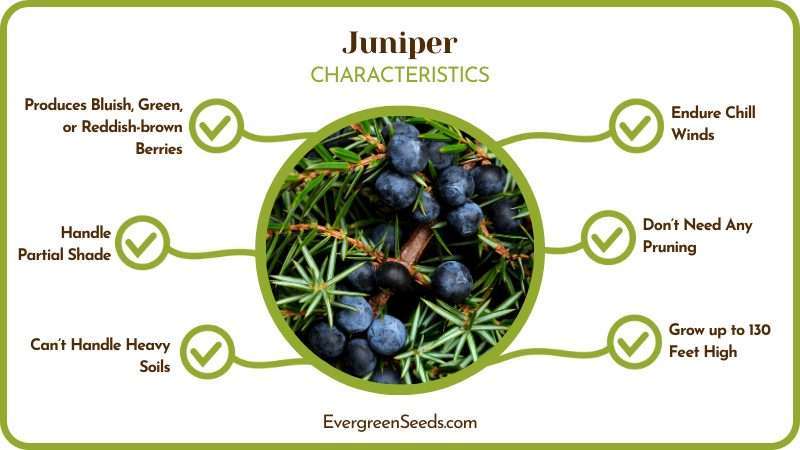
Cypress needs more water until it establishes roots but grows much better because of it. In USDA zones 9–10, water it with 10 gallons of water a month per inch of trunk diameter. Keep doing it for 3 months. In zones 7–8, make it 4 gallons a month and keep doing it for six months.
Cypress trees that are 3–5 years old need roughly half that water. Trees 6–7 years old need roughly a third of the amounts written above. Use soaker hoses instead of sprinklers, which can cause leaf rot. Check up on the cypress more often if it’s planted near an object that reflects heat.
Soil Requirements
Junipers can tolerate many soil types but can’t handle heavy soils that often get wet. They like soils with pH between 5 and 7 and don’t grow well in sandy or clay-like soil types. Such soils can still improve through composting. You can add pumice, perlite, or vermiculite to the soil; the added texture will help the juniper grow.
Cypress can grow in almost any soil but can’t handle soil with a pH over 7.5. It also needs well-drained soils, which you can test yourself. Dig a hole in the soil and fill it with water. If it drains by 2 inches an hour, it’s got good drainage for a cypress.
Fruits
The Juniper family produces berries that are bluish, green, or reddish-brown. They have a waxy coating. Some juniper berries are edible, some only irritate, and others are poisonous.
Cypress fruits can be balls with scales that release winged seeds. They are 1/3 to 1 inch in size and have four to 14 scales. Cypress can also produce cones, which are reddish-brown when ripe. None of the cypress fruits are edible.
Landscaping Uses
Junipers have a perfect place in landscaping for privacy and decoration purposes. Ground cover juniper species can serve well as a living fence. Dwarf species are perfect for container growing, giving a lot of pizzazz to a garden or patio. All juniper species are a good choice to protect the soil from erosion.
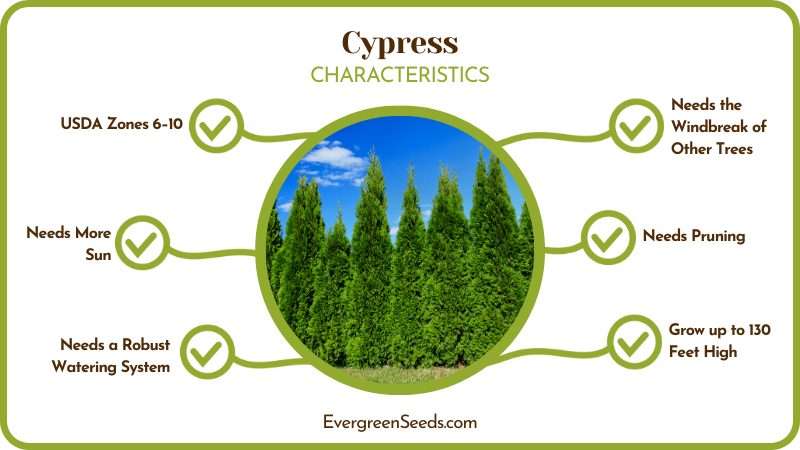
Groups of healthy cypress trees serve as an excellent windbreak. Those same groups are also a great privacy screen but give them enough space. Funnily enough, juniper combines with cypress, so plant juniper shrubs beneath cypress trees.
Be aware that cypresses commonly topple over when they reach 50+ feet height due to shallow roots. Avoid species that go sky-high and choose smaller cypress trees.
Fertilization
You don’t need to fertilize a cypress if it grows 2 inches of twigs in a year. If you use a fertilizer, make it one with more nitrogen than phosphorus and potassium, such as 18-10-10. Give it one that has trace elements, such as calcium and sulfur. A 12–14 month slow-release fertilizer sprinkled in spring is ideal.
Juniper needs fertilizer in early spring but none at other times. Use a slow-release 10-10-10 fertilizer. Spread it evenly around the tree, but don’t let it touch the trunk. Water the fertilizer until it dissolves into the soil.
Mulching
Juniper needs only a thin layer of mulch during the summer. It will keep the moisture in and stop the weeds. Make it a 1–2 inch layer of shredded wood. Cure the mulch and make sure it’s at least 1 year old.
A young cypress tree needs a 2–3 inch layer of mulch around it. Let mulch be out of pine needles, straw or bark but don’t let it touch the trunk. Mulch once a year.
Pests
Juniper and cypress can be hurting from these pests:
- aphids
- bark beetles and mealybugs
- flatheaded borers
- needle miners
- webworms
- root nematodes
- sawflies
- spider mites
Use insecticide only if you notice an overwhelming number of those pests. In small numbers, insects are not a problem; predators that appear normally will take care of them.
Pruning
Cypress’ dead branches should go off as soon as you spot them. If they are yellow, you might still be able to save them; if they are brown, they are gone. Otherwise, you should only prune a cypress to make it a nice shape. Do not prune more than 1/3 of any given cypress branch.
Junipers almost don’t need any pruning. In fact, pruning them too much may hurt them. Old junipers can suffer a lot when pruned because they grow slowly. Yet, you should snip off stray twigs to give the plant a pleasing look.
When you do start pruning, use sharp shears. Disinfect them using a 10 percent bleach solution or isopropyl (rubbing alcohol). Clean your pruning tool after each plant.
Juniper and Cypress Diseases
Both juniper and cypress can be beset by root rot.
This disease comes on the back of several fungi, but the symptoms are always the same:
- poor needle and plant growth
- needle color turns brown or light yellow
- discolored wood above the soil line
- winter twig dieback
There is no cure for root rot, and there’s no guarantee it won’t infect other plants in the same soil. The only thing you can do is prevent damage to the root system. Be careful with mowing and digging around the plant. Drain the soil well, and don’t choose places near downspouts as planting spots.
Juniper and cypress can also be beset by twig blight. You can cure it by pruning and throwing away infected twigs. Make sure there’s enough air circulation around the plant and keep the foliage dry. Scale back on fertilizing the diseased plant to avoid cypress and juniper problems.
Cypress and Juniper Leaf Burn
Leaf burn can cause the leaves of cypresses and junipers to go black. It always happens to plants in poor growing conditions. For example, frost combined with strong wind can cause leaf burn. When that happens, juniper and cypress leaves turn brown or yellow. You can notice the color change at the leaf tip and along the margins.
Cypresses and junipers planted near thoroughfares can also have leaf burn. In that case, the most common cause is salt spray from passing vehicles.
The only solution to leaf burn is making sure the planting spot is fine.
Cypress vs Juniper Essential Oils
Cypress and juniper are rich in oils that people can squeeze and market as essential oils. When mixed up with other oils, such as coconut oil, they have a pleasant smell and cause less irritation.

Leaves and stems of a Mediterranean cypress tree (Cupressus sempervirens) have cypress essential oil. The main ingredient is camphene, a substance often used in anti-cough herbal remedies. Cypress essential oil is a great addition to homemade soaps, washes, and detergents.
Juniper (Juniperus communis) berries and needles hold the juniper essential oil. You can use it to make a living space smell and feel great. That can boost the good vibes in a living space and make relaxation in it easy. Bugs and mosquitoes don’t like cypress and juniper essential oils, so try either oil as a homemade bug spray.
Final note:
Juniper rarely needs pruning, but for cypress, it is a must


